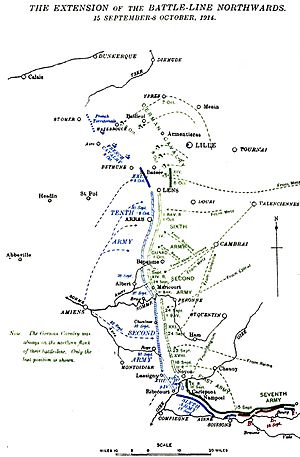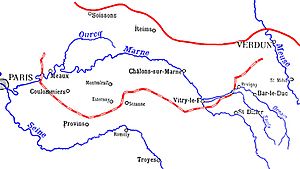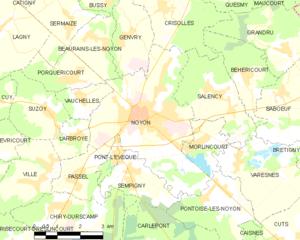First Battle of Picardy facts for kids
Quick facts for kids First Battle of Picardy |
|||||||
|---|---|---|---|---|---|---|---|
| Part of the Race to the Sea, First World War | |||||||
 Franco-German northward flanking moves, 15 September – 8 October 1914 |
|||||||
|
|||||||
| Belligerents | |||||||
| Commanders and leaders | |||||||
| Joseph Joffre Michel-Joseph Maunoury Noel de Castelnau |
Erich von Falkenhayn Alexander von Kluck Rupprecht of Bavaria |
||||||
| Strength | |||||||
| Sixth Army Second Army |
1st Army 6th Army |
||||||
| Casualties and losses | |||||||
| unknown | unknown | ||||||
The First Battle of Picardy (22–26 September 1914) was an important fight during the early part of World War I. It happened as part of the "Race to the Sea" (17 September – 19 October). This "race" was when both the French and German armies tried to get around each other's northern side.
This battle followed the First Battle of the Marne (5–12 September), where the French stopped the German advance into France. After the Marne, both sides tried to outflank, or go around, the other's army. This led to a series of battles as the front line stretched northwards through Picardy, Artois, and Flanders.
In Picardy, the French Sixth Army attacked first, moving along the Oise river. They aimed to go around the German 1st Army. Soon, the French Second Army joined in, trying to push even further north.
The French armies managed to advance a bit, reaching a line from Roye to Chaulnes. But then, the German 6th Army arrived as reinforcements. They stopped the French advance. After this, both sides tried another flanking move even further north. This led to the next big fight, the Battle of Albert.
Contents
Background to the Battle
The "Race to the Sea" Begins
After the Battle of the Marne, the German army pulled back and dug in along the Aisne river. Both sides then realized they couldn't easily break through the enemy's front lines. So, they started trying to go around the enemy's open side, or "flank."
This led to a series of moves where each army tried to extend its lines further north and west. They hoped to get around the other army and win the war quickly. This back-and-forth movement became known as the "Race to the Sea."
German Plans
General Erich von Falkenhayn became the new head of the German army on 14 September. He faced a tough choice. The German army was spread out, and he needed to decide where to send his troops. He wanted to keep attacking to win the war.
Falkenhayn decided to move the German 6th Army from Lorraine to the right side of the German lines. His plan was to use this army to go around the French and British armies. He hoped this would lead to a big, decisive battle.
French Counter-Moves
The French commander, General Joseph Joffre, also wanted to keep attacking. He ordered his armies to advance and push the Germans back. He also started moving French troops from other areas, like Lorraine, to the western side of the front.
The French used their railways to quickly move soldiers to the left flank. This allowed them to try and outflank the Germans as well. On 17 September, the French Sixth Army attacked near Soissons and Noyon, starting the first major clash in this "race."
Preparing for Battle
Troop Movements Northward
As the "Race to the Sea" continued, both sides kept sending more soldiers to the northern part of the front. The German IX Reserve Corps arrived from Belgium by 15 September. The German 6th Army was also on its way from Lorraine.
The French also moved their armies around. General Joffre sent General Noël Édouard, vicomte de Curières de Castelnau and the French Second Army headquarters to the north. They took over several army corps to prepare for a new attack.
The new French Second Army got ready to attack on 22 September. Their goal was to advance from Lassigny north to Roye and Chaulnes. They wanted to go around the German army's side.
The Germans also kept bringing in more troops. The XXI Corps and the I Bavarian Corps arrived around 24 September. They were immediately sent to extend the German front line northwards. They aimed to stop the French advance and push them back.
The Battle Unfolds
Fighting from 22 to 26 September
The French Second Army crossed the Avre river, moving from Lassigny towards Roye and Chaulnes. But they quickly ran into German troops. The German II Corps had just arrived from the Aisne front.
The Germans, with help from their cavalry, were pushed back a bit. The French advance threatened important German supply routes through Ham and St. Quentin. This made the Germans send even more troops to the area.
On 24 September, the German XVIII Corps attacked towards Roye. They pushed back the French IV Corps. Further north, the French Second Army reached Péronne and set up a position on the east bank of the Somme river. This was as far as they could go for then.
Joffre sent the last French reserve, the XI Corps, to the Second Army. The German XXI and I Bavarian corps then recaptured Péronne. They forced the French Second Army back to the west of the Somme river. The French dug in on good defensive ground from Lassigny to Roye and Bray.
On 25 September, a German attack near Noyon pushed the French Second Army back again. From 25 to 27 September, there was heavy fighting all along the Western Front. After this, both sides focused their main efforts further north, leading to the Battle of Albert.
The German attacks in Picardy gained very little ground. After a short break, the Germans attacked the French Second Army again. The French were pushed back from Lassigny to a line from Ribecourt to Roye. On 1 October, the Germans attacked at Roye, and on 5 October, another attack at Lassigny was stopped. On 7 October, a French counter-attack took 1,600 German prisoners.
Aftermath
The Race Continues North
The fighting in Picardy showed that neither side could easily outflank the other. The "Race to the Sea" continued as both armies kept trying to extend their lines further north.
The German II Bavarian Corps and XIV Reserve Corps pushed back a French division near Bapaume. They advanced towards Bray and Albert. From 25 to 27 September, French troops and cavalry defended the areas around Albert.
By 28 September, the French managed to stop the German advance on a line from Maricourt to Fricourt and Thiépval. The German cavalry was also stopped near Arras by French cavalry. On 29 September, Joffre formed a new French army, the Tenth Army, to fight in this northern area. The battle lines continued to extend towards the Channel coast.




